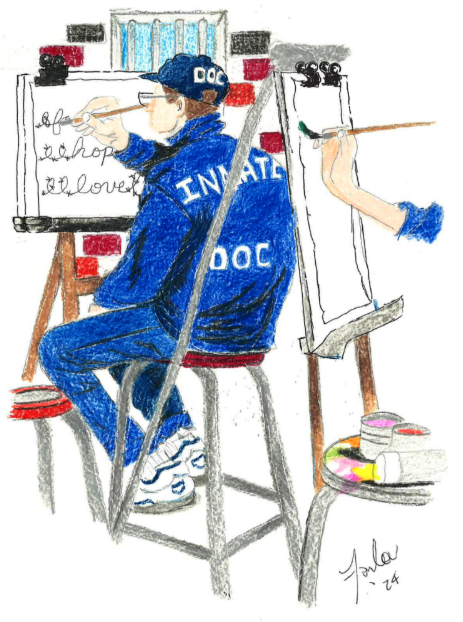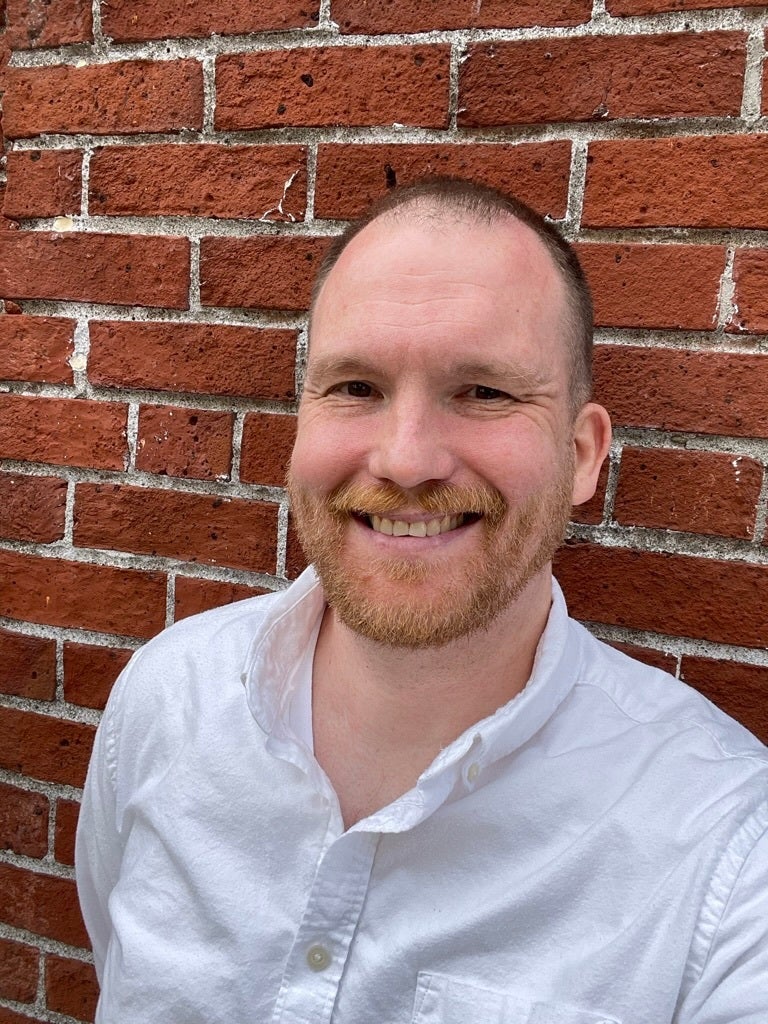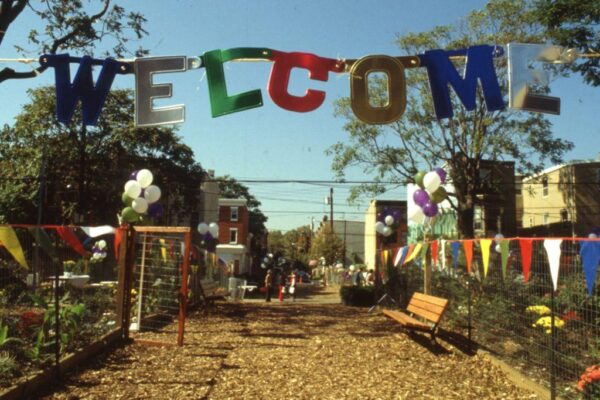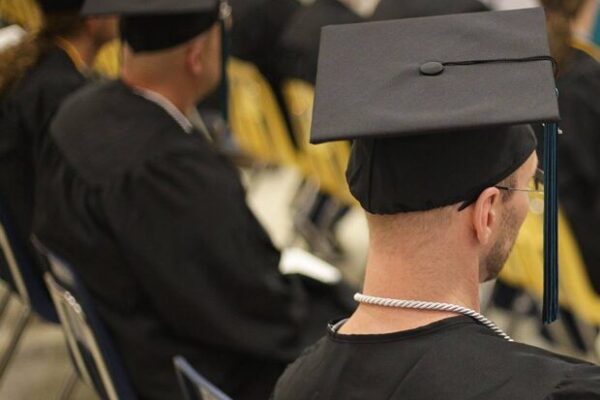
The Artist of this piece, Gary Farlow, tells us that “In 2022, the Rand Corporation reported that access to education reduces prison recidivism by 43%, yet, as many incarcerated will attest, rehabilitation is left largely up to the prisoner. There are no road maps to navigate the minefield called prison.” His artwork calls us to move forward in the hope that barbed wire can become love, hope and something reimagined. Read more of Gary’s thoughts here.
Dear Reader,
Thank you for engaging with our second-chance month series this year. We hope you were inspired and challenged throughout each blog. Throughout this series, we’ve witnessed how education and community collaboration create pathways that shape our authors’ individual identities and how their work informs and impacts the greater community. From Vy Thang’s exploration of utopian ideals to Wyatt Reed’s artistic journey, each story demonstrates that such expression requires a network of support—truly, it takes a village.
Our contributors have shown how education transcends traditional classroom boundaries. Allen Ivanov’s reflection on Shakespeare revealed how intellectual pursuits can bridge isolation, while Michael Munro’s gaming metaphors illustrated how failure becomes a tool for growth when supported by community. Laz Sargeant’s poetry and dave rich’s prose demonstrated how creative expression builds connections across prison walls.
The series highlighted innovative approaches to rehabilitation. Ignacio Carrillo’s work with animal programs showed how unconventional partnerships between prisons, shelters, and volunteers foster empathy and reduce recidivism. Shane Bell’s advocacy for education beyond “Good Enough Diplomas” challenged us to reimagine what’s possible within correctional systems.
Throughout these narratives, we’ve seen how individuals flourish when:
- Educational institutions provide accessible resources
- Mentors offer guidance and support
- Peer networks foster community learning
- Creative outlets enable self-expression
- Cross-sector partnerships expand opportunities
As we conclude this series, we’re reminded that such chances, that we have here labeled second, aren’t granted in isolation – they’re cultivated through collective effort. These stories prove that combining education, empathy, and community support creates pathways for the narrative on who is incarcerated to change. This series proves that no single entity holds the key to reform—it takes a village to dismantle barriers and cultivate hope. By sharing stories, expanding access, and forging alliances, we build a future where second chances are not exceptions but expectations.
Behind every Second Chance Month series story stands a dedicated team that helped bring these powerful narratives to life. Our contributors worked tirelessly to create a platform where voices from inside prison walls could reach beyond them, fostering dialogue and understanding across communities. Thank you to ITHAKA for creating a workplace that supports such efforts; the entire firm contributed to the soundtrack. But I must add a few personal shout-outs:
Stacy Lyn Burnett: Thank you for your leadership of JSTOR Access in Prison, which laid the foundation for this initiative. You kicked us off with a bang, demanding both our readers and us as editors that “These stories remain raw and honest, exactly as they were when the writers bravely sealed their envelopes and released their truths into the world.”
Grace Cope, Maria Papadouris, and Rumika Hillyer: Your design and social media expertise ensured these stories were presented in ways that honored their creators’ visions. Thank you for the long hours, content creation, and formatting debates within the group and across platforms. Grace, thank you for being my wing woman, hype man, and brainstorm partner in crime across all the projects currently circulating. Additionally, thank you for stepping in as and when competing obligations popped up.
Ryan McCarthy: Your technical expertise, voice-overs, and content creation made these narratives accessible to a broader audience. Thank you for loving Shakespeare, understanding the needs of our authors in a profoundly intimate way, and jumping in even as your vacation time was encroached upon.
Together, we created a digital space where these important voices could be heard, seen, and interacted with in comprehensive ways that embodied personhood. Which is so often stripped from those serving time inside the justice system.
Again, and most importantly, we thank our contributors – the writers, artists, and thinkers who shared their stories of reshaping identity through education. Their willingness to be vulnerable, to challenge perceptions, and to inspire change has made this series possible.
Thank you, dear reader, for being a part of this village.
Sincerely and in solidarity,
Elizabeth Shatswell
Correctional Education Manager, JSTOR
We continue striving for innovative ways to showcase those we serve. Please continue to engage with us:
- Explore the complete Second Chance Month series: Justice Initiatives Archives
- Learn more about JSTOR Access in Prison
- Sign up for our newsletter, The Catalyst
- Listen to the Second Chance Month Soundtrack
Meet the entire team

Elizabeth Shatswell serves as the Correctional Education Manager at JSTOR Access in Prison. A strong advocate for the transformative power of storytelling, she believes community is created through the sharing of our collective tales. Elizabeth is an alumnus of the Freedom Education Project Puget Sound (FEPPs), the Sunshine Lady Foundation, and the University of Puget Sound.

Elizabeth Shatswell serves as the Correctional Education Manager at JSTOR Access in Prison. A strong advocate for the transformative power of storytelling, she believes community is created through the sharing of our collective tales. Elizabeth is an alumnus of the Freedom Education Project Puget Sound (FEPPs), the Sunshine Lady Foundation, and the University of Puget Sound.

Grace Cope is a designer and researcher at JSTOR Access in Prison and JSTOR Labs who works to build more accessible and intuitive user experiences. Continuously informed by art, collective storytelling, and political education, Grace teaches Jewish songs in carceral spaces.

Stacy Lyn Burnett has managed JSTOR Access in Prison for the past three years, ensuring people in jails and prisons have access to academic resources. Currently, more than one million incarcerated learners have JSTOR access on three continents. She took her first-ever college class as a student of Bard Prison Initiative, and post-release, she earned an MBA in Sustainability from Bard Graduate Center.
The opinions and views expressed in these recordings, art, and posts are those of the authors and do not represent, reflect, or imply endorsement by ITHAKA.


